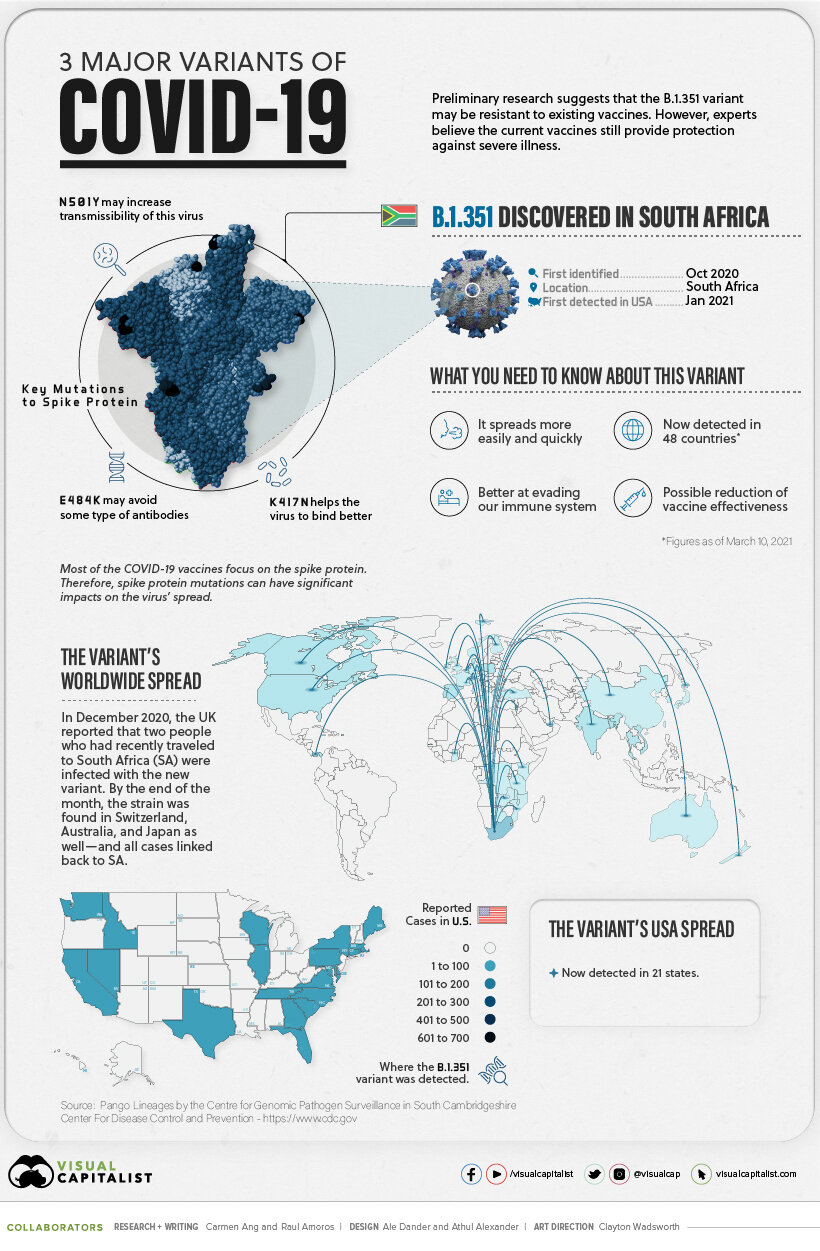The U.S. has registered nearly 550k deaths from COVID-19, nearly 20% of global reported deaths from the virus, according to the Johns Hopkins dashboard of coronavirus data. Globally, 127.5M cases have resulted in nearly 2.8M deaths. Roughly a month after the World Health Organization declared COVID-19 to be a pandemic, just 1M cases had been registered globally.
Photos from visualcapitalist.com.
By the end of March, 28.5% of the U.S. population had received their first dose of a coronavirus vaccination and 15.7% were fully vaccinated. The raw data shows that nearly 165M vaccine doses have been administered, of which roughly 150M have been given since President Joe Biden was inaugurated on January 20. With a month to go to complete his "first 100 days," Biden recently announced a new goal to administer 200M vaccine doses before April 30.
The United States government has issued multiple trillion dollars in stimulus and relief packages for Americans. Notably, the Higher Education Relief Fund under the CARES (Coronavirus Aid, Relief, and Economic Security) Act provided needed financial aid to many Covenant students. Most recently, the American Rescue Plan Act of 2021 released $1.9 trillion in "rescue" dollars. The Rescue Plan allows $1400 stimulus checks to be sent to qualifying Americans, provides various unemployment benefits and increases the Child Tax Credit maximum for young age groups. The Child Tax Credit is projected to decrease the number of poverty-stricken American children by 45% through monthly payments. Additional components of the Rescue Plan will bolster funding for public health response, provide grants for restaurants and bars, and make school safer, among other responses.
These responses are laudable, yet the global response to COVID-19 continues to unfold with new challenges and an understanding of the virus that grows steadily.
Three significant COVID-19 variants, called B.1.1.7, B.1.351 and P.1, have spread globally. Preliminary research suggests that these variants spread more quickly than and may have various advantages over the original coronavirus. This may result in reduced efficacy of certain COVID-19 vaccines in those infected with these variants, though the word on this is still developing.
The emergence of variants is well understood by virologists and other infectious disease specialists; however, the origin of the SARS-CoV-2 coronavirus is still being investigated. Early findings of a World Health Organization probe into various potential coronavirus origins in China are slowly unfolding. These findings suggest that the most likely origin of the pandemic virus is a bat-to-human species jump by an intermediate animal host. The possibility that the virus was leaked from a lab is reportedly very unlikely. A reservoir host—an animal in which a virus lives and circulates perpetually—for COVID-19 has not been identified.
Here are some things to look for as the science of COVID-19 develops and global pandemic response strengthens. The COVID-19 vaccine released by Pfizer and BioNTech is currently pursuing trials of the vaccine in children as young as six months old.
New developments and landmarks can be followed on the Pfizer website: www.pfizer.com/science/coronavirus/vaccine/additional-population-studies. The extent to which vaccines are administered globally can be followed here: ourworldindata.org/grapher/covid-vaccination-doses-per-capita?tab=map&time=latest. Lastly, the BBC has an article thread and a series of videos on what diseases epidemiologists are saying could lead to future global epidemics and what can be done in preparation.



